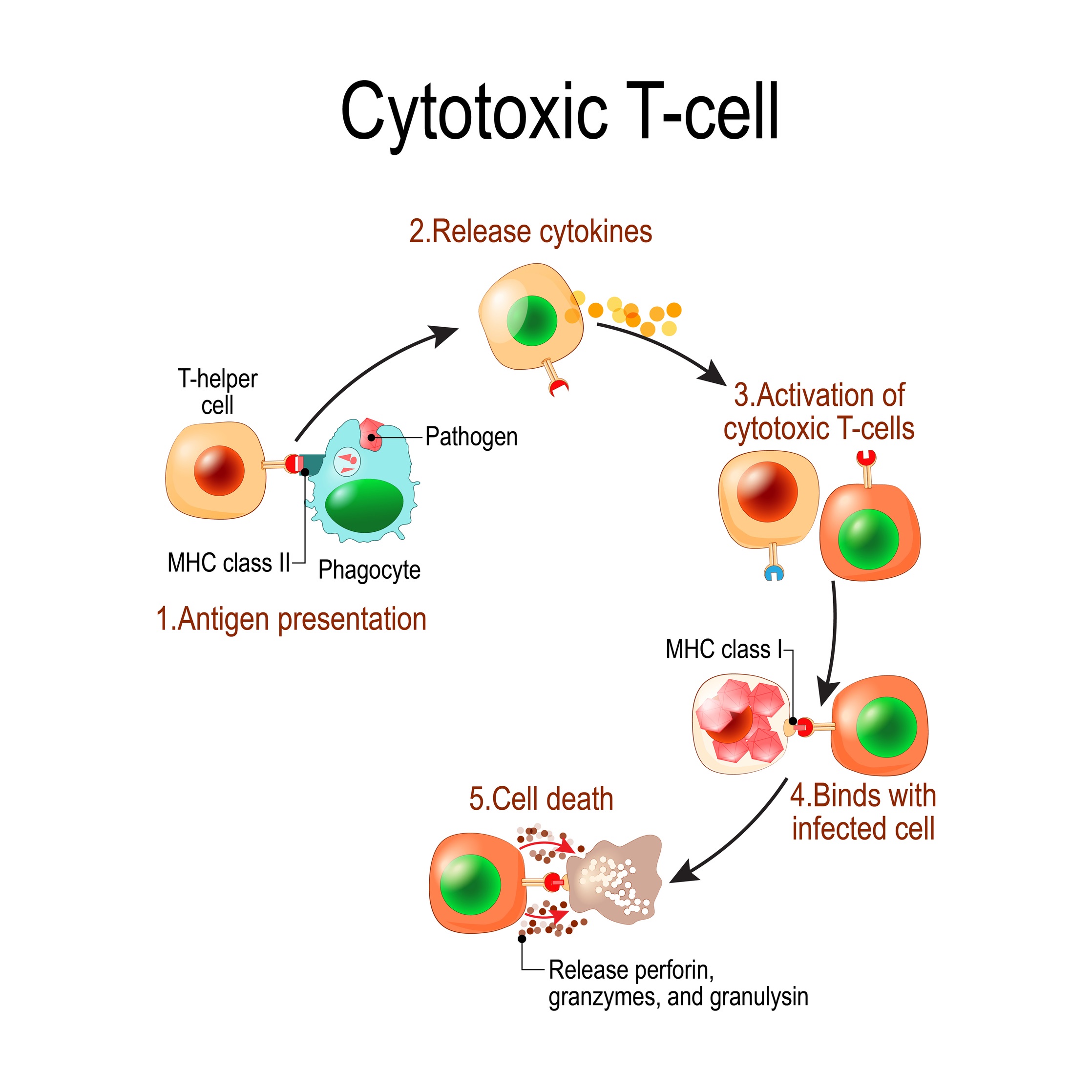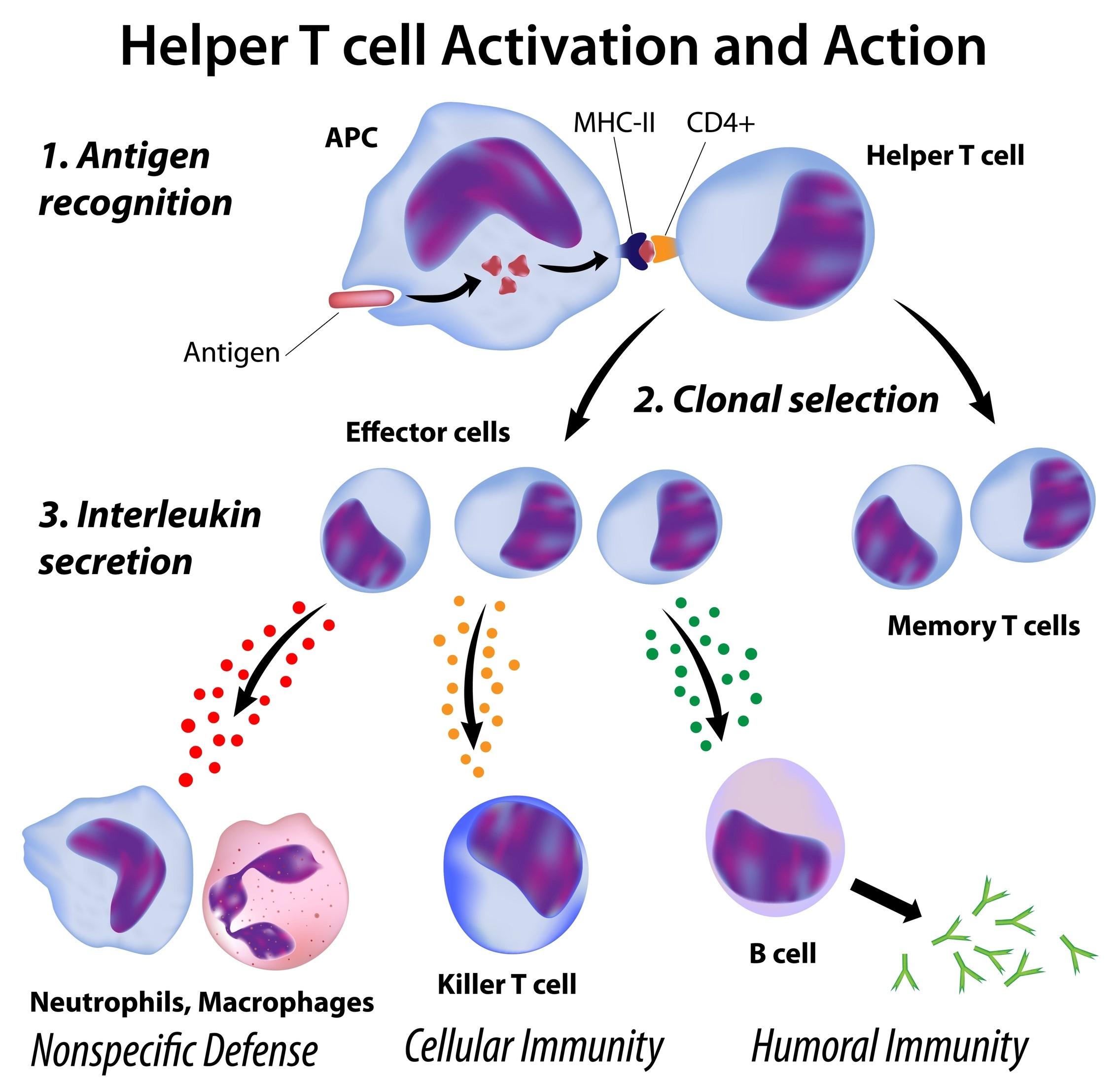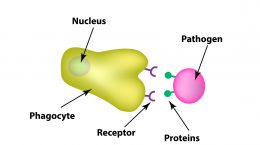Published on September 4, 2020
The development of immunity to a pathogen through natural infection is a complex process that typically takes place over a couple of weeks and involves the innate and adaptive immune systems. With the innate immune system, the body responds immediately with a non-specific response in which phagocytes work to slow the progress of the infection and may prevent it from causing symptoms. On the other hand, the adaptive immune response includes
i) humoral immunity, covered previously, where the body makes antibodies that specifically bind to the pathogen and
ii) cellular immunity where T cells recognize and eliminate other cells infected with the pathogen. A previous post has briefly covered how vitamin D is involved with T cell activity. This post will focus on a more general overview of cellular immunity carried out by T cells.
T cells are the Maestro of the Orchestra
The adaptive immune system starts to work after the innate immune system is activated. If an infection progresses despite the inflammation, fever, and phagocyte activity of the innate immune system, a more coordinated response is required in order to destroy the pathogen. T cells orchestrate cells from both the innate and adaptive immune systems in an attempt to overcome the pathogen.

T cells (also called T lymphocytes) carry out cell-mediated immunity that does not involve antibodies, but their roles include interacting with macrophages and dendritic cells, directly killing pathogen-infected cells, activating other immune cells, producing signals that talk to all types of cells, and regulate the immune response. That’s a lot of work! There are several types of T cells that specialize in the various roles they perform.
Types of T Cells
Naïve T cells are T cells that have not yet encountered the specific antigen that they recognize. Once a naïve T cell encounters its specific antigen, it becomes activated, and it multiplies into many sister cells (all clones of the original T cell that react to the same antigen, similar to how B cells are activated).
There are two main types of T cells that differ based on the type of receptor they have: CD8+ or CD4+.
Cytotoxic T Cells (CD8+ T Cells): Cytotoxic T cells kill their target cells by releasing toxic granules into the cell to be killed. Their main function is to kill cells that may be infected with a virus or bacteria, but they also kill tumorous cells.
T helper Cells (CD4+ T cells): T helper cells (Th) have a wide range of functions and further develop into different subtypes: Th1, Th2, Th17 and Regulatory T cells (Treg). The CD4 protein recognizes specific molecules which hold antigens presented by cells that have already engulfed and digested the pathogen, such as macrophages and dendritic cells.
The many roles of T helper cells include activating other immune cells, releasing cytokines (chemical signals that instruct other cells what to do), and helping B cells produce antibodies.
Memory T Cells are formed by both CD8+ and CD4+ T cells when the immune response has been triggered by their specific antigen. They are long-lived and are easily activated so that they are able to quickly expand to large numbers of Cytotoxic T cells (CD8+) or T helper cells (CD4+) when they are presented with that antigen again.

What do Nutrients have to do with T cells?
The COVID-19 pandemic has shone the light on the role of nutrients in immune functioning, and for good reason.
Nutrients are cofactors for processes throughout the body. Nutrients play roles in immune system function by regulating immune cell function, working to produce the ammunition to destroy pathogens and producing armor to protect you when your immune cells have to fire that ammunition in the body. Some nutrients of particular concern for T cell function include vitamins D, C, A, E, B6 and B12 and folate, iron, zinc, copper, and selenium. When your body doesn’t get enough of these necessary nutrients, the immune system is compromised and doesn’t work at its full potential.
In previous posts we have reviewed the major role vitamin D plays in T cell function. Vitamin D is needed to activate naïve T cells and to respond to a pathogen. Vitamin D influences T cell maturation through regulating the types of cytokines produced (anti-inflammatory vs. inflammatory) and by influencing antigen presenting cells. Many nutrients in addition to vitamin D are needed for proper immune function. GrassrootsHealth will continue to bring you important information about the roles of these nutrients in future posts. Please let us know if there is a topic you want to hear about!
Nutrients Work Together for Immune and Overall Health!
Do you know your own nutrient levels? Do you know your levels of inflammation? Could getting more of certain nutrients help to decrease your levels of inflammation, and improve your immune response? Find out by testing your vitamin D, omega-3s, magnesium and other essential elements (including copper and zinc), as well as your inflammation levels, with the new Immune Boost home test kit offered by GrassrootsHealth. Measuring levels is the only way to know if you are supporting your immune system and whether additional changes should be made, with supplementation, dietary changes, or both.
Enroll now with the Full Immune Boost Panel (which includes tests for vitamin D, Omega-3 Index, magnesium, zinc, selenium, copper, and hsCRP), and get 10% off when you use coupon code BoostTen at checkout.
Are You Getting Enough Vitamin D to Help Yourself?
We’re in a time of great crisis that could be greatly affected by making sure you and everyone you know has a serum level of at least 40 ng/ml. Help us help you.
Do you know what your vitamin D level is? Be sure to test today to find out, and take steps to keep it within a target of 40-60 ng/ml or 100-150 nmol/L! Give your immune system the nutrients it needs to support a healthy you and protect yourself from unnecessary diseases, especially COVID-19.
Through GrassrootsHealth Nutrient Research Institute, you can also test your essential elements magnesium, copper, zinc and selenium, toxins such as lead, mercury and cadmium, as well as your omega-3 levels, inflammation levels and thyroid stimulating hormone (TSH) level. Find out your levels today! Log on to the test selection page (click the link below) to get your tests and see for yourself if your levels can be improved.
Make sure you track your results before and after, about every 6 months!
How can I track my nutrient intake and levels over time?
To help you track your supplement use and nutrient levels, GrassrootsHealth has created the Personal Health Nutrient Decision System called
For each specific supplement, you can track what days you take it, how much, and many other details. This will help you know your true supplemental intake and what patterns of use work for you to reach and maintain optimum nutrient levels. Check it out today!







